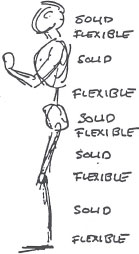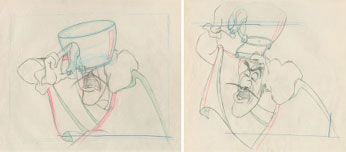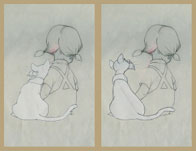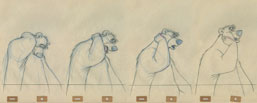Many of you who were adventurous enough to experiment with the cylinders last session were very successful. I noticed a very marked improvement in several artists’ work. Now, I’d like to suggest you concentrate, at least for a portion of the meeting, on combining the cylinders with the solid-flexible concept.

The solid-flex thing is the basis for all the angles that portray the various actions, moods, and expressions that we are called upon to draw. Each section has a limited, yet unique movement to perform. Those movements are the means through which we express all of our body communications. Try to relate some incident in your life, or mimic someone else’s with your neck in a brace and your hands tied behind your back. You would make up for it by bending at the waist and the knees. You would make the whole upper part of your body do what your head normally does, and the bending of your knees take the place of hand gestures.
In addition to these readable, “communicate-able” movements of the solid-flex portions of the body, we use an accent motion called “opposing force.” That motion is preceded by what we call anticipation. Every move we make has those two elements, sometimes almost imperceptibly subtle, and sometimes wildly exaggerated.
Here is an example of an opposing force. Bernard starts out in a part squash pose, then opens his arms outward and his head upward — all in opposing directions. (Note the tangent of the tail and hand in the first and second drawing — not good)

Another example where Ollie Johnston worked Rufus’ lower jaw against his scarf for an opposing force.

Here’s a less subtle example. Notice how hand and pot go up while the head and left shoulder lower:

Another — quite exaggerated yet very delicate:

Another:

And yet another:

These are all gestures we use in different degrees during our daily living. Slightly, in ordinary circumstances, more exaggerated when mimicking or telling a story, and greatly magnified when animating. Go back over these examples and study how the solid-flex parts of the body were employed to execute those movements. Work your eyes from drawing to drawing observing the use of angle against angle, squash against stretch, and close proximity to openness.
